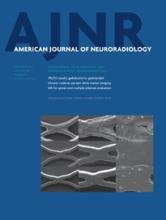Research ArticleBrain
Open Access
Macro- and Microstructural Changes in Patients with Spinocerebellar Ataxia Type 6: Assessment of Phylogenetic Subdivisions of the Cerebellum and the Brain Stem
K. Sato, K. Ishigame, S.H. Ying, K. Oishi, M.I. Miller and S. Mori
American Journal of Neuroradiology January 2015, 36 (1) 84-90; DOI: https://doi.org/10.3174/ajnr.A4085
K. Sato
aFrom the Russell H. Morgan Department of Radiology and Radiological Science (K.S., K.I., K.O., S.M.)
fDepartment of Radiology (K.S.), Juntendo University School of Medicine, Tokyo, Japan
K. Ishigame
aFrom the Russell H. Morgan Department of Radiology and Radiological Science (K.S., K.I., K.O., S.M.)
gDepartment of Radiology (K.I.), University of Yamanashi, Yamanashi, Japan
S.H. Ying
bDepartments of Radiology (S.H.Y.)
cNeurology (S.H.Y.)
dOphthalmology (S.H.Y.)
K. Oishi
aFrom the Russell H. Morgan Department of Radiology and Radiological Science (K.S., K.I., K.O., S.M.)
M.I. Miller
eCenter for Imaging Science (M.I.M.), Johns Hopkins University School of Medicine, Baltimore, Maryland
S. Mori
aFrom the Russell H. Morgan Department of Radiology and Radiological Science (K.S., K.I., K.O., S.M.)
hF.M. Kirby Research Center for Functional Brain Imaging (S.M.), Kennedy Krieger Institute, Baltimore, Maryland.

References
- 1.↵
- Taroni F,
- DiDonato S
- 2.↵
- Nagaoka U,
- Suzuki Y,
- Kawanami T, et al
- 3.↵
- Eichler L,
- Bellenberg B,
- Hahn HK, et al
- 4.↵
- 5.↵
- Yagishita A
- 6.↵
- Schulz JB,
- Borkert J,
- Wolf S, et al
- 7.↵
- 8.↵
- Eccles JC
- 9.↵
- Grimaldi G,
- Manto M
- 10.↵
- Fulton JF,
- Dow RS
- 11.↵
- Wang X,
- Wang H,
- Xia Y, et al
- 12.↵
- Dietrichs E
- 13.↵
- Mandelli ML,
- De Simone T,
- Minati L, et al
- 14.↵
- Prakash N,
- Hageman N,
- Hua X, et al
- 15.↵
- 16.↵
- 17.↵
- Trouillas P,
- Takayanagi T,
- Hallett M, et al
- 18.↵
- Jones DK,
- Horsfield MA,
- Simmons A
- 19.↵
- Mori S,
- Oishi K,
- Jiang H, et al
- 20.↵
- Oishi K
- 21.↵
- Woods RP,
- Grafton ST,
- Watson JD, et al
- 22.↵
- Beg MF,
- Miller MI,
- Trouve A, et al
- 23.↵
- Miller MI,
- Trouve A,
- Younes L
- 24.↵
- Miller MI,
- Beg MF,
- Ceritoglu C, et al
- 25.↵
- Buckner RL,
- Krienen FM,
- Castellanos A, et al
- 26.↵
- Faria AV,
- Zhang J,
- Oishi K, et al
- 27.↵
- Seidel K,
- Siswanto S,
- Brunt ER, et al
- 28.↵
- Basser PJ,
- Jones DK
- 29.↵
- Le Bihan D,
- Turner R,
- Douek P, et al
- 30.↵
- 31.↵
- Iwata NK,
- Ugawa Y
- 32.↵
- 33.↵
- Yang Q,
- Hashizume Y,
- Yoshida M, et al
- 34.↵
- 35.↵
- Le Bihan D,
- van Zijl P
- 36.↵
- Mori S,
- Zhang J
- 37.↵
- Tievsky AL,
- Ptak T,
- Farkas J
- 38.↵
- Takagi T,
- Nakamura M,
- Yamada M, et al
In this issue
American Journal of Neuroradiology
Vol. 36, Issue 1
1 Jan 2015
Advertisement
K. Sato, K. Ishigame, S.H. Ying, K. Oishi, M.I. Miller, S. Mori
Macro- and Microstructural Changes in Patients with Spinocerebellar Ataxia Type 6: Assessment of Phylogenetic Subdivisions of the Cerebellum and the Brain Stem
American Journal of Neuroradiology Jan 2015, 36 (1) 84-90; DOI: 10.3174/ajnr.A4085
0 Responses
Macro- and Microstructural Changes in Patients with Spinocerebellar Ataxia Type 6: Assessment of Phylogenetic Subdivisions of the Cerebellum and the Brain Stem
K. Sato, K. Ishigame, S.H. Ying, K. Oishi, M.I. Miller, S. Mori
American Journal of Neuroradiology Jan 2015, 36 (1) 84-90; DOI: 10.3174/ajnr.A4085
Jump to section
Related Articles
- No related articles found.
Cited By...
- No citing articles found.
This article has not yet been cited by articles in journals that are participating in Crossref Cited-by Linking.
More in this TOC Section
Similar Articles
Advertisement











